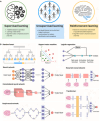A New Perspective on Precision Medicine: The Power of Digital Organoids
- PMID: 40129676
- PMCID: PMC11931648
- DOI: 10.34133/bmr.0171
A New Perspective on Precision Medicine: The Power of Digital Organoids
Abstract
Precision medicine is a personalized medical model based on the individual's genome, phenotype, and lifestyle that provides tailored treatment plans for patients. In this context, tumor organoids, a 3-dimensional preclinical model based on patient-derived tumor cell self-organization, combined with digital analysis methods, such as high-throughput sequencing and image processing technology, can be used to analyze the genome, transcriptome, and cellular heterogeneity of tumors, so as to accurately track and assess the growth process, genetic characteristics, and drug responsiveness of tumor organoids, thereby facilitating the implementation of precision medicine. This interdisciplinary approach is expected to promote the innovation of cancer diagnosis and enhance personalized treatment. In this review, the characteristics and culture methods of tumor organoids are summarized, and the application of multi-omics, such as bioinformatics and artificial intelligence, and the digital methods of organoids in precision medicine research are discussed. Finally, this review explores the main causes and potential solutions for the bottleneck in the clinical translation of digital tumor organoids, proposes the prospects of multidisciplinary cooperation and clinical transformation to narrow the gap between laboratory and clinical settings, and provides references for research and development in this field.
Copyright © 2025 Qian Yang et al.
Conflict of interest statement
Competing interests: The authors declare that they have no competing interests.
Figures






Similar articles
-
Lung cancer organoids: models for preclinical research and precision medicine.Front Oncol. 2023 Oct 24;13:1293441. doi: 10.3389/fonc.2023.1293441. eCollection 2023. Front Oncol. 2023. PMID: 37941550 Free PMC article. Review.
-
Bridging the gap: how patient-derived lung cancer organoids are transforming personalized medicine.Front Cell Dev Biol. 2025 Apr 15;13:1554268. doi: 10.3389/fcell.2025.1554268. eCollection 2025. Front Cell Dev Biol. 2025. PMID: 40302940 Free PMC article. Review.
-
Advances in the application of colorectal cancer organoids in precision medicine.Front Oncol. 2024 Dec 3;14:1506606. doi: 10.3389/fonc.2024.1506606. eCollection 2024. Front Oncol. 2024. PMID: 39697234 Free PMC article. Review.
-
Exploring Tumor-Immune Interactions in Co-Culture Models of T Cells and Tumor Organoids Derived from Patients.Int J Mol Sci. 2023 Sep 27;24(19):14609. doi: 10.3390/ijms241914609. Int J Mol Sci. 2023. PMID: 37834057 Free PMC article. Review.
-
Organoids-On-a-Chip for Personalized Precision Medicine.Adv Healthc Mater. 2024 Dec;13(30):e2401843. doi: 10.1002/adhm.202401843. Epub 2024 Oct 13. Adv Healthc Mater. 2024. PMID: 39397335 Review.
Cited by
-
Applications in osteochondral organoids for osteoarthritis research: from pathomimetic modeling to tissue engineering repair.Front Bioeng Biotechnol. 2025 Jul 23;13:1629608. doi: 10.3389/fbioe.2025.1629608. eCollection 2025. Front Bioeng Biotechnol. 2025. PMID: 40771720 Free PMC article. Review.
-
From niche to organoid: Engineering bone tissues through microenvironmental insights.J Tissue Eng. 2025 Jul 29;16:20417314251358567. doi: 10.1177/20417314251358567. eCollection 2025 Jan-Dec. J Tissue Eng. 2025. PMID: 40755459 Free PMC article. Review.
References
-
- König IR, Fuchs O, Hansen G, Mutius E, Kopp MV. What is precision medicine? Eur Respir J. 2017;50(4):1700391. - PubMed
Publication types
LinkOut - more resources
Full Text Sources
Miscellaneous

